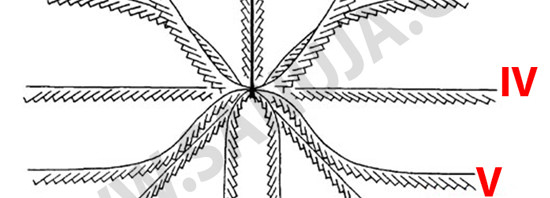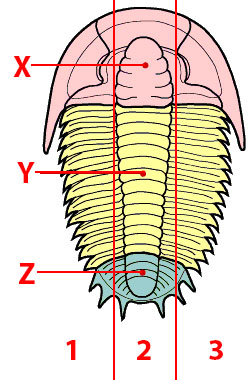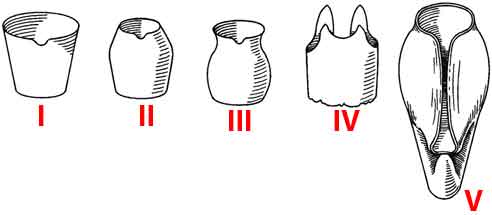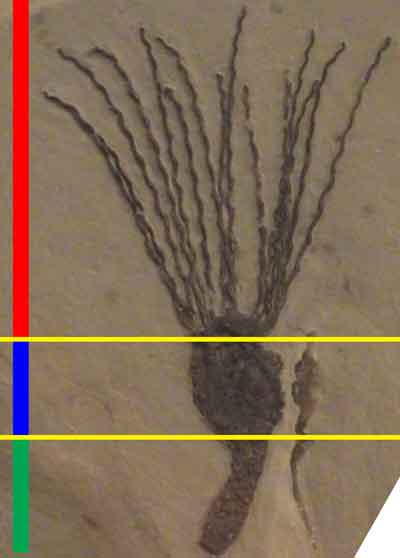GLGY 491 – Paleobiology
Disclaimer: While every reasonable effort is made to ensure that the information provided is accurate, no guarantees for the currency or accuracy of information are made. It takes several proof readings and rewrites to bring the quiz to an exceptional level. If you find an error, please contact me as soon as possible. Please indicate the question ID-Number or description because server may randomize the questions and answers.
Go to: Midterm I | Midterm II
If you get an answer wrong, please keep selecting other options to reveal the correct answer and explanation (if it is available). You should be able to score at least 95% (if not, go back and study your notes) because the scoring algorithm is: # right answers – # of attempts / # of questions answered * 100. So even in the middle of the quiz, you will be able to grade yourself on how well you did up that point without completing the entire quiz.
Geology (GLGY 491-UCAL) Final Exam
Congratulations - you have completed Geology (GLGY 491-UCAL) Final Exam.
You scored %%SCORE%% out of %%TOTAL%%.
Your performance has been rated as %%RATING%%
Question 1 |
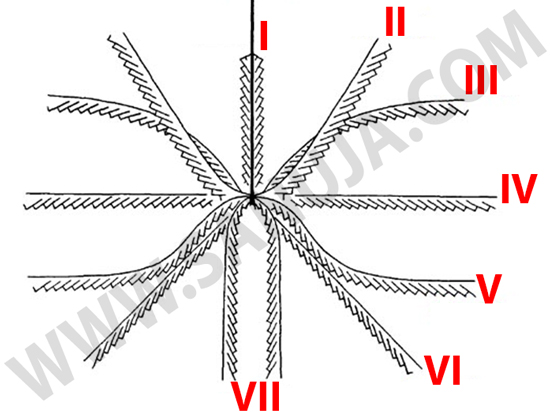
A | VI |
B | I |
C | V |
D | II |
E | III |
F | IV |
G | VII |
Question 2 |
A | I. Silurian II. Permian-Triassic Crisis |
B | I. Ordovician II. Permian-Triassic Crisis |
C | I. Cambrian II. Paleogene-Cretaceous Crisis |
D | I. Ordovician II. Paleogene-Cretaceous Crisis |
E | I. Silurian II. Paleogene-Cretaceous Crisis |
F | I. Cambrian II. Permian-Triassic Crisis |
Question 3 |
A | hyponomic sinus |
B | mural |
C | anulus (or annulus) |
D | anterior suture |
E | septum |
Question 4 |
A | Carboniferous |
B | Cambrian |
C | Permian |
D | Ordovician |
E | Devonian |
Question 5 |
A | ~ 35 cm |
B | ~ 100 cm |
C | ~12 cm |
D | ~ 150 cm |
Question 6 |
A | Middle Devonian |
B | Middle Ordovician |
C | Early Silurian |
D | Early Cambrian |
E | Early Ordovician |
Question 7 |
A | Cambrian |
B | Silurian |
C | Permian |
D | Devonian |
Question 8 |
A | At the Cretaceous/Paleogene |
B | At the Triassic/Jurassic |
C | At the Ordovician/Silurian |
D | At the Permian/Triassic |
Question 9 |
A | Middle Jurassic |
B | Silurian |
C | Upper Cambrian |
D | Lower Devonian |
E | Lower Permian |
Question 10 |
A | siphuncle, left lateral pleural lobe |
B | cephalon, right lateral pleural lobe |
C | thorax, left lateral pleural lobe |
D | thorax, right lateral pleural lobe |
E | siphuncle, right lateral pleural lobe |
F | cephalon, left lateral pleural lobe |
Question 11 |
A | Complete (or near complete) loss of symmetry. |
B | Compression of shell structures. |
C | Development of feet. |
D | Expansion of shell structures creating round or elliptical shape. |
Question 12 |
A | ~ 100 - 190 |
B | ~ 50 - 200 |
C | ~ 190 - 300 |
D | ~ 50 - 300 |
Question 13 |
A | biochemical |
B | calcitic |
C | delicious |
D | arragonitic |
E | siliceous |
Question 14 |
A | Late Silurian , Devonian |
B | Early Ordovician, Permian |
C | Upper Ordovician , Permian |
D | Upper Ordovician , Carboniferous |
E | Early Silurian , Permian |
Question 15 |
A | Asaphida |
B | Proetida |
C | Phacopida |
D | Ptychopariida |
E | Agnostida |
Question 16 |
A | 150 million years old |
B | 210 million years old |
C | 160 million years old |
D | 50 million years old |
E | 180 million years old |
F | 110 million years old |
Question 17 |
Please note do not use the Internet for this question. The prof has a different eon for Belemnites than what is commonly stated in literature. 🙂 (ID-PBF-43)
A | Middle Permian |
B | Late Paleozoic (aka upper Pz) |
C | Late Cretaceous (aka upper K) |
D | Early Cretaceous (aka lower K) |
E | Early Permian (aka lower P) |
Question 18 |
A | Based on the shape of the axis (curved or not) of addition. |
B | Based on the coiling direction and the nature of the coil. |
C | Based on the length to width ratio. |
D | Based on the position of the proloculus (first chamber). |
E | Based on the environment; benthic vs planktonic. |
Question 19 |
A | I. nodes II. sulci |
B | I. nodes II. dips |
C | I. lobes II. sulci |
D | I. lobes II. dips |
E | I. peaks II. troughs |
Question 20 |
A | By having small boney plates that are interconnected. |
B | By increasing the size of the tail. |
C | By increasing the size of gills. |
D | By splitting the tail into parts. |
Question 21 |

A | scandent |
B | pendent |
C | reclined |
D | recurved |
E | nema |
F | decurved |
Question 22 |
A | False |
B | True |
Question 23 |
A | Devonian |
B | Permian |
C | Carboniferous |
D | Silurian |
E | Cambrian |
Question 24 |
A | They reproduce asexually. |
B | They are typically found in extremely cold water environments such as the arctic. |
C | They are marine organisms. |
D | They evolved during the Cambrian explosion. |
E | They have no known predators. |
Question 25 |
A | Devonian |
B | Late Paleozoic (aka upper Pz) |
C | Jurassic |
D | Late Cambrian (aka upper ∈) |
E | Early Cretaceous (aka lower K) |
F | Silurian |
Question 26 |
A | False |
B | True |
Question 27 |
A | They do not have organs or specialized cells. |
B | They are Invertebrates. |
C | They have very strong evolutionary links to cephalochordates and urochordates. |
D | They are mammals. |
Question 28 |
A | democrystals |
B | bio-calcites |
C | synthetically produced calcites |
D | oligocrystals |
Question 29 |
A | Isotelus rex |
B | Niobids |
C | Ogygites |
D | Eurypterus |
E | Trinucleus |
Question 30 |
A | two-fold with a mirrored plane |
B | Pentameral |
C | Irregular |
D | Regular |
Question 31 |
A | Silurian |
B | Ordovician |
C | Ediacaran |
D | Cambrian |
E | Permian |
Question 32 |
A | False |
B | True |
Question 33 |
A | I. Late Cambrian II. Middle Devonian |
B | I. Early Silurian II. Early Devonian |
C | I. Early Cambrian II. Late Ordovician |
D | I. Early Cambrian II. Late Cambrian |
E | I. Early Silurian II. Middle Devonian |
Question 34 |
A | Mid Devonian |
B | Late Silurian (aka upper S) |
C | Early Permian (aka lower P) |
D | Late Cambrian (aka upper ∈) |
E | Mid Cretaceous |
Question 35 |
A | Silurian |
B | Ordovician |
C | Cambrian |
D | Jurassic |
E | Permian |
Question 36 |
A | Nipponites |
B | Aragonauta |
C | Ceratites |
D | Nautilus |
E | Baculites |
Question 37 |
A | nema |
B | theca |
C | autotheca |
D | stipe |
E | sicula |
F | nema |
Question 38 |
A | Enterponeuts |
B | Urochordates |
C | Tunicates |
D | Cephalochordates |
Question 39 |
A | spherical |
B | pentameral |
C | radial |
D | bilateral |
E | lacks symmetry |
Question 40 |
A | I. Asterozoa II. Ophiuroidea |
B | I. Ophiuroidea II. Asterozoa |
C | I. Hughmilleria II. Stylonurus |
D | I. Hughmilleria II. Pterygotus |
E | I. Pterygotus II. Hughmilleria |
Question 41 |
A | open |
B | visored |
C | constricted |
D | contracted |
E | peristome projections |
Question 42 |
A | Agnostida |
B | Phacopida |
C | Ptychopariida |
D | Redlichiida |
E | Corynexochida |
Question 43 |
A | Early Permian (aka lower P) |
B | Late Cambrian (aka upper ∈) |
C | Late Paleozoic (aka upper Pz) |
D | Middle Triassic |
E | Early Cretaceous (aka lower K) |
Question 44 |
A | False |
B | True |
Question 45 |
A | Agnostida because they were the last one to undergo extinction. |
B | Proetida because they are the most abundant across the world. |
C | Asaphida because they were found in almost all continents of the world. |
D | Agnostida because they were found in almost all continents of the world. |
E | Proetida because they were the last one to undergo extinction. |
Question 46 |
A | ventral |
B | anterior |
C | septal |
D | posterior |
Question 47 |
A | Agnostida |
B | Proetida |
C | Redlichiida |
D | Asaphida |
E | Lichida |
Question 48 |
A | Early Cambrian |
B | Late Devonian |
C | Middle Cambrian |
D | Late Cambrian |
E | Early Devonian |
Question 49 |
A | Ventral |
B | Anterior |
C | Dorsal |
D | Posterior |
Question 50 |
A | Devonian to Early Carboniferous |
B | Jurassic to Holocene (Recent) |
C | Cambrian to Late Permian |
D | Late Paleozoic to Mesozoic |
Question 51 |
A | inhalant siphon |
B | exhalant siphon |
C | byssal threads |
D | digestive track |
Question 52 |
A | I. Mesozoic II. Permian/Triassic |
B | I. Mesozoic II. Triassic/Jurassic |
C | I. Ordovician II. Permian/Triassic |
D | I. Cambrian II. Triassic/Jurassic |
E | I. Ordovician II. Triassic/Jurassic |
Question 53 |
A | contracted |
B | visored |
C | peristome projections |
D | constricted |
E | open |
Question 54 |
A | No symmetry due to advanced evolution of the species. |
B | Coiled |
C | Bilateral |
D | Pentameral |
Question 55 |
A | They are valuable as a jewellery. |
B | They are indicator fossils that often leads to deposits of coal. |
C | They are used in cutting saws and other tools. |
D | They be used to determine the best areas for oil and gas extraction. |
Question 56 |
A | their shell is consist of several small shelly parts. |
B | they have several different spines on their shell for defense. |
C | they have several sets of eyes. |
D | their muscles are consist of several specialized tissues. |
E | they have many feet. |
Question 57 |
A | Early Cambrian |
B | Upper Cambrian |
C | Late Devonian |
D | Early Devonian |
E | Lower Cambrian |
F | Middle Cambrian |
Question 58 |
A | Chewing |
B | Movement |
C | Respiratory |
D | Circulatory |
Question 59 |
A | Lower Cambrian |
B | Upper Cretaceous Hint: Played a major role; but this is NOT when it evolved. |
C | Permian |
D | Lower Silurian |
Question 60 |
A | True |
B | False because they occurred in non primitive chordates. |
C | False because gills are never (even in most advanced form) a morphological feature of Hemicordate. |
D | False because while some chordates had gills, majority of primitive chordates had none. |
Question 61 |
A | Bactritoids |
B | Ceratites |
C | Belemnites |
D | Nautilids |
Question 62 |
A | They have a shell composed of inorganic matter. |
B | Their colour will varies with heat. |
C | They have a shell composed of agglutinated silicon particles. |
D | They are the direct ancestors of modern humans. |
Question 63 |
A | hyponomic sinus |
B | cardinal sinus |
C | proloculus |
D | septal neck |
Question 64 |
A | Smooth outer shell (carapace) |
B | Spines |
C | Large, 360-degree type eyes |
D | Segmented carapace |
Question 65 |
A | pygidium |
B | cephalon |
C | siphuncle |
D | thorax |
E | axial lobe |
Question 66 |

A | decurved , horizontal |
B | decurved , pendent |
C | scandent , pendent |
D | recurved , horizontal |
E | reclined , horizontal |
F | recurved , pendent |
G | scandent , horizontal |
Question 67 |
A | Evolute |
B | Torticone |
C | Gyrocone |
D | Brevicone |
E | Involute |
Question 68 |
A | I. Middle Ordovician II. Paleogene-Cretaceous Crisis |
B | I. Early Silurian II. Paleogene-Cretaceous Crisis |
C | I. Late Cambrian II. Paleogene-Cretaceous Crisis |
D | I. Late Cambrian II. Permian-Triassic Crisis |
E | I. Middle Ordovician II. Permian-Triassic Crisis |
F | I. Early Silurian II. Permian-Triassic Crisis |
Question 69 |
A | ~ 30 cm |
B | ~ 100 cm |
C | ~ 70 cm |
D | ~ 5 cm |
Question 70 |

A | I |
B | III |
C | V |
D | II |
E | IV |
F | VII |
Question 71 |
A | Late Cretaceous (aka upper K) |
B | Early Cretaceous (aka lower K) |
C | Late Paleozoic (aka upper Pz) |
D | Early Permian (aka lower P) |
E | Middle Permian |
Question 72 |
A | False |
B | True |
Question 73 |
A | open |
B | peristome projections |
C | visored |
D | contracted |
E | constricted |
Question 74 |
A | Torticone |
B | Gyrocone |
C | Evolute |
D | Involute |
E | Brevicone |
Question 75 |
A | Involute |
B | Gyrocone |
C | Brevicone |
D | Evolute |
E | Torticone |
Question 76 |
A | Saccabambaspis |
B | Astraspis |
C | Lasanius |
D | Placoderms |
Question 77 |
A | Nipponites |
B | Aragonauta |
C | Baculites |
D | Nautilus |
E | Ceratites |
Question 78 |

A | decurved , declined |
B | recurved , scandent |
C | decurved , recurved |
D | decurved , pendent |
E | recurved , pendent |
F | recurved , declined |
Question 79 |
A | Movement across surfaces |
B | Sexual reproduction |
C | Buoyancy control (up-down movement in water) |
D | Defense and prey |
Question 80 |
A | Determining the depth of burial. |
B | Determining the reasons for Cambrian explosion. |
C | Determining the pale-enviroment. |
D | Determining the causes of Permian-Triassic extinction. |
Question 81 |
Original Image: http://commons.wikimedia.org/wiki/File:Gogia_spiralis_Utah.jpg
A | stem(red), theca(blue), holdfast(green) |
B | ventral cavity(red), body cavity(blue), root structure(green) |
C | brachioles(red), theca(blue), stem(green) |
D | brachioles(red), theca(blue), holdfast(green) |
E | ventral cavity(red), bulbus(blue), root structure(green) |
F | stem(red), brachioles(blue), theca(green) |
Question 82 |
A | open |
B | visored |
C | constricted |
D | contracted |
E | peristome projections |
← |
List |
→ |
| 1 | 2 | 3 | 4 | 5 |
| 6 | 7 | 8 | 9 | 10 |
| 11 | 12 | 13 | 14 | 15 |
| 16 | 17 | 18 | 19 | 20 |
| 21 | 22 | 23 | 24 | 25 |
| 26 | 27 | 28 | 29 | 30 |
| 31 | 32 | 33 | 34 | 35 |
| 36 | 37 | 38 | 39 | 40 |
| 41 | 42 | 43 | 44 | 45 |
| 46 | 47 | 48 | 49 | 50 |
| 51 | 52 | 53 | 54 | 55 |
| 56 | 57 | 58 | 59 | 60 |
| 61 | 62 | 63 | 64 | 65 |
| 66 | 67 | 68 | 69 | 70 |
| 71 | 72 | 73 | 74 | 75 |
| 76 | 77 | 78 | 79 | 80 |
| 81 | 82 | End |
You may download this exam as a PDF file here.
Credits: Based on the excellent class notes provided by, Dr. Marius (Dan) Georgescu during Fall 2013. Proofreading and corrections were made by fellow students in GLGY 491 course.
FAQ | Report an Error
Since, Dr. Georgescu decided to repeat some of the questions from the first two midterms, some questions posted on this quiz may also have appeared on the previous 491 quizzes. However, please study the BlackBoard questions for previous exam questions.
In case in you have missed the additional support materials, please visit the main Exams & Resources page and check under GLGY 491. Note: No questions from the two midterms are posted here. But there will be some questions from them on the final. Refer to previous 491 exams.
Quick… save the world!
The world is about to get hit by a meteorite. The computer that controls the high intensity electron beam (use for destroying the extraterrestrial objects) has been hijacked by Graptolites. But they got a riddle for you. What are their orientation from I to VII? If you name them in 30 seconds or less, you may be able to save the world (Disclaimer: Probably of saving the world is a function of the power of the electron beam and it is inversely related to the time in which it take you to shoot it. In other words, the longer your take, 1/t will result in unfavorable outcomes. Once the riddle is solved, you will be granted with the access code. However, use it wisely!).

